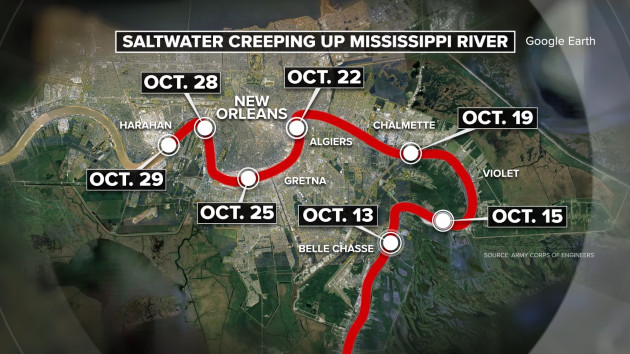(NEW YORK) — More than a million people around New Orleans are now within weeks of saltwater polluting their water supply for the first time in 35 years as officials work around the clock to address the problem.
Drought, subsidence, rising seas and manmade changes to the river have led to historically low water levels in the Mississippi River and allowed saltwater from the Gulf of Mexico to creep up the river and into local water sources.
Councilman Mitch Jurisch is among 4,000 people in Plaquemines Parish, Louisiana, who have already been dealing with high chloride levels in their water for months. The area encompasses the lowest part of the river before it reaches the Gulf of Mexico.
“We got the word on June 19 that the chloride level had risen from like 250 to 700-something parts per million overnight. It sparked, you know, panic,” Jurisch told ABC News.
Levels of chloride, which gives drinking water a salty taste, are recommended to stay below 250 parts per million under guidelines set by the Environmental Protection Agency.
These guidelines are known as secondary drinking standards regulations and pertain to contaminants — like chloride — that may have cosmetic effects, such as skin or tooth discoloration, or aesthetic effects, such as taste, odor, or color, in drinking water. The EPA recommends these standards to water systems but does not require them to comply with them. On the other hand, regulations for primary contaminants, which have a known health threat, are legally enforceable, according to the EPA.
“People don’t realize just how important of a commodity water is to us. But when you see it shut down schools, businesses, changing people’s lives,” Jurisch said.
Jurisch lives about an hour south of New Orleans, but the saltwater is now moving up the Mississippi River and could reach the city as soon as Oct. 22, according to the Army Corps of Engineers.
“Now unfortunately, the last two years we’ve seen those flows be low enough to where the Gulf of Mexico has started to creep into the state,” Casey Tingle, director of the Louisiana Governor’s Office of Homeland Security and Emergency Preparedness, told ABC News.
A spokesperson for the Sewerage and Water Board of New Orleans (SWNBO) said in a statement, “Due to its vast size, New Orleans’ water treatment plant poses the biggest challenge within the region.”
The SWNBO treats up to 165 million gallons of water every day, on average, and serves nearly 400,000 residents and millions of visitors annually to the city’s historic neighborhoods like the French Quarter, the statement said.
The city plans to build a pipeline that would pump in fresh water from about 12 miles upriver, the statement said. The SWNBO is also coordinating with the U.S. Army Corps of Engineers to barge in fresh water from upriver to its smaller intakes for the Westbank of New Orleans.
“In both cases, the fresh water will be added to the river near the intakes to dilute the salty water for treatment and keep chloride levels below 250 parts per million,” the statement said.
The U.S. Army Corps of Engineers constructed a sill, an underwater barrier, in July to create an artificial basin to help delay the ingress of saltwater. The upriver intrusion of saltwater overtopped the sill’s elevation earlier this week. They are now working to build the sill higher.
Back in Plaquemines Parish, President Keith Hinkley is hoping to upgrade water treatment facilities in the area with permanent reverse osmosis devices, which he says can cost up to $5 million a piece.
“The goal in the future is this right here, should this happen, it’s the residents in the community won’t even experience it. They won’t feel it. You know, they’ll get some news that, hey, the river’s being intruded by salt again, but we’re on top of it. We’re ahead of it, and we have everything under control,” Hinkley said.
Louisiana Gov. John Bel Edwards submitted a request to President Joe Biden for a Federal Emergency Declaration last week over the intrusion of saltwater into the Mississippi River.
There are currently three water systems in Louisiana that are under advisories for sodium and chloride — two in Plaquemines Parish and one in St. Mary Parish, according to the Louisiana Department of Health.
The EPA does not classify sodium as a primary or secondary contaminant, but the Louisiana Department of Health recommends that people who are on dialysis for kidney disease or low-sodium diets check with their health care providers related to the levels of chloride and sodium in their drinking water.
Water that has exceeded 250 parts per million of chloride should not be consumed by pregnant women and should not be used to mix with baby formula, according to the department.
Copyright © 2023, ABC Audio. All rights reserved.












